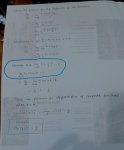Hello all, I have a question about proofing the derivative of lnx = 1/x.
Quoting from Kumon,

I understand from top to mid until I read the one that I circled with a blue pen.
I don't understand how we can get to the conclusion that the lim k-> 0 ln(1+k)^1/k = 1 just from the lim t->~ (1+1/t)^t = e.
Sorry for the bad quality picture and sorry if I posted in the wrong section.
Thank you.
Quoting from Kumon,
I understand from top to mid until I read the one that I circled with a blue pen.
I don't understand how we can get to the conclusion that the lim k-> 0 ln(1+k)^1/k = 1 just from the lim t->~ (1+1/t)^t = e.
Sorry for the bad quality picture and sorry if I posted in the wrong section.
Thank you.
Attachments
Last edited:


